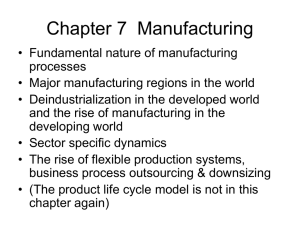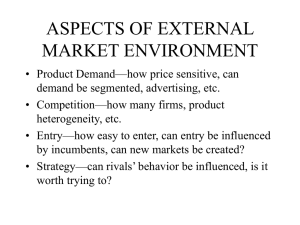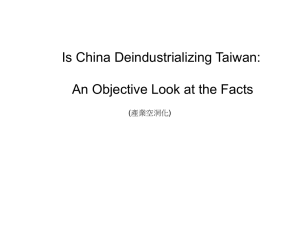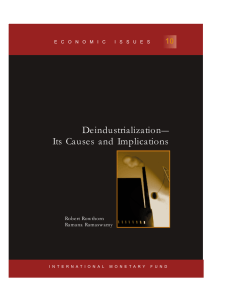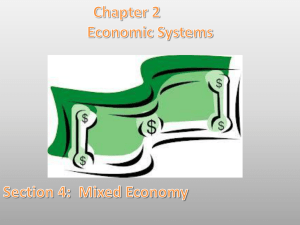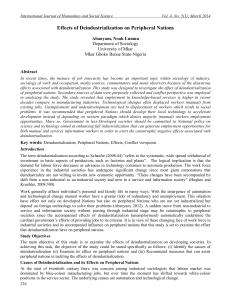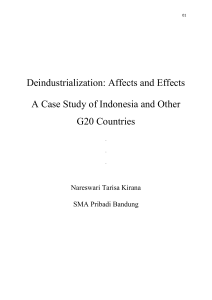New Industrial Policy
advertisement
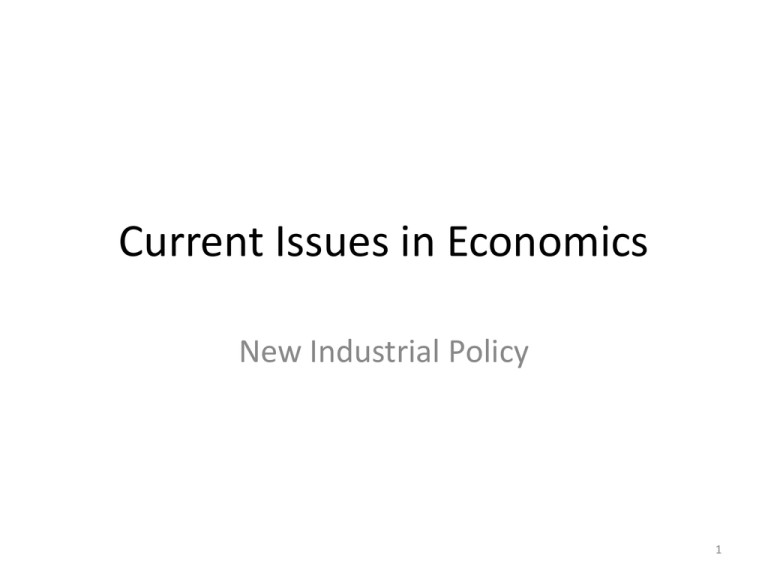
Current Issues in Economics New Industrial Policy 1 New Industrial Policy “Are we becoming a nation of hamburger flippers?” Ronald Regan 2 New Industrial Policy Reasons for industrialization - manufacturing has special properties as an engine of growth: • dynamic economies of scale; • strong backward and forward linkages between manufacturing and other sectors of the domestic economy; • strong properties of learning-by-doing; innovation and technological progress; • the importance of manufacturing for the balance of payments • way of catching-up for developing countries Evidence • US becomes a superpower with standards of living unmatched in history • early success of Soviet Union • success of Asian Tigers (Korea, Taiwan, Singapore) • unprecedented success of China 3 New Industrial Policy Short History of Industrial Policy: • 40 – 50ties post-IIWW reconstruction effort (Marshall Plan, IBRD) • 60 – 70ties post-colonial catch-up effort • 80 – early 00 anathema (Washington Consensus) • Over the last few years revival of the industrial policy as a legitimate part of economic policy 4 New Industrial Policy Explanations of deindustrialization • specialization, referring to the domestic outsourcing of activities previously performed in house in manufacturing to specialized service providers; • statistical effect: fall in the relative prices of manufactured goods means that they account for a smaller share of consumer expenditure • “barber effect”: higher rate of productivity growth in manufacturing relative to services is associated with slower employment growth in manufacturing than in services, even if output increases at the same rate 5 New Industrial Policy Explanations of deindustrialization (cont) • international trade negatively affects manufacturing employment in advanced economies by: – increasing productivity through higher competitive pressures, eliminating low-value added activities or inefficient firms, – by replacing relatively labor intensive activities subject to import pressures with less labor-intensive activities producing sophisticated exports • decrease in the rate of investment tend to decrease the share of manufacturing (in both employment and GDP), since a disproportionately large share of investment expenditure is accounted for by manufactures. 6 New Industrial Policy Globalization: Ricardo’s Comparative Advantage at Work: • Developed countries have comparative advantage in high value added parts of the production stream: design, financing, marketing • Developing countries have comparative advantage in low value added parts of production • Technological progress in transport and communication make it feasible 7 New Industrial Policy Forces at the firm level “The defining challenge for competitiveness has shifted, especially in advanced countries. The challenges of a decade ago were to restructure, lower cost, and raise quality. Today, continued operational improvement is a given, and companies in many countries are able to acquire and deploy the best current technology. In advanced nations with relatively high labor costs and equal access to global markets, producing standard products using standard methods will not sustain competitive advantage. Instead, advantage must come from the ability to create and then commercialize new products and processes, shifting the technology frontier as fast as their rivals can catch up.” National Innovative Capacity; Porter, Stern 8 New Industrial Policy Over the last few years revival of the industrial policy as a tool for reindustrialization WHY? It is essential to increase productivity in manufacturing industry and associated services to underpin the recovery of growth and jobs, restore health and sustainability to the EU economy and help sustain our social model (EC 2014) 9 New Industrial Policy Gene from the bottle: • In the last decade the global business environment has changed radically. EU industry competes with China, Brazil, India and other emerging economies also on high-value products. And putting it back: • You can produce comparatively expensive product in developed countries b/c of automatization and robotization reduce dramatically labor component of costs 10 New Industrial Policy Conservative Agenda for NIP “Government on its own cannot create growth. It is the decisions of business leaders, entrepreneurs and individual workers which build our economy. What the Government can do is provide the conditions for success to promote a new economic dynamism — harnessing our economic strengths, removing the barriers which prevent markets from supporting enterprise, and putting the private sector first when making decisions on tax, regulation and spending. “ UK Treasury 2010 11 New Industrial Policy Radical Agenda for NIP “A far more proactive role of the state is required. The state can proactively create strategy around a new high growth area before the potential is understood by the business community (from the internet to nanotechnology),funding the most uncertain phase of the research that the private sector is too risk-averse to engage with, seeking and commissioning further developments, and often even overseeing the commercialization process. In this sense it has to play an important entrepreneurial role.” M. Mazzucato, 2011 12 New Industrial Policy NEW APPROACH TO EU INDUSTRIAL POLICY Strategy framework for a new industrial competitiveness policy must put the competitiveness and sustainability of European industry at center stage. This requires that industrial policy is understood in its wider sense: • First, it is about those policies that have an impact on the cost, price and innovative competitiveness of industry and individual sectors, such as standardization or innovation policies, or sectoral policies targeting e.g. the innovation performance of individual sectors. • Second, it is necessary to consider the competitiveness effects of all other policy initiatives such as transport, energy, environmental or social and consumer-protection policies, but also the single-market policy or trade policies. They are crucial components of the overall package as they can have an important influence on the cost, price and innovative competitiveness of industry. 13 New Industrial Policy 14 New Industrial Policy Reindustrialization as a challenge • Reindustrialization a sustained increase in both the share of manufacturing in total employment and the share of manufacturing in GDP. • Reindustrialization, not simply a case of ‘inverse deindustrialization’ as there would be different dynamics at work • There is an asymmetry in that reindustrialization is less likely to ‘just happen’ under market forces than is the case with a similar magnitude of deindustrialization 15 New Industrial Policy Why picking the winners sometimes works but mostly not? Government agencies are always at risk of putting money into “bad bets” and “bad apples.” They are also inherently rigid, risk-averse, and reluctant to innovate, because they know that if they deviate from the letter of the law, or if an innovation goes awry, they will be chastised politically. And costly, ineffective programs are notorious for surviving indefinitely because they develop powerful defenders. 16 New Industrial Policy Political economy of Industrial Policy • The challenge is not to: – Pick a few winners among the existing industries, but rather to facilitate the emergence of more winners by broadening the business ecosystem and enabling it to nurture new activities. – It is not the policymakers’ role to hasten death of less efficient firms. Competition inevitably tends to remove the less efficient firms and industries • State task is to identify productivity-enhancing interventions that can strengthen economies by adding new activities and productive capabilities 17 New Industrial Policy Developing countries that have deindustrialized face more acute challenges than developed ones. • Deindustrialization in developing countries can be considered ‘premature’ in the sense that of commencing at lower levels of income per capita than was generally the case for deindustrialization in advanced economies. • Furthermore, deindustrialization in developing countries resulted from policy shifts—in particular trade and financial liberalization— rather than just with the ‘maturation’ of their economic structure; • Competition from China and other low-cost manufacturers in Asia affects developing countries especially hard, as competing in the manufacture of similar types of goods. Developing countries can be unable to compete with China on cost grounds, yet lacking the technology, skills, and market access to compete higher up the value chain with developed countries. 18 New Industrial Policy When old-style industrial policy works: Taiwan, Korea, China • The global segmentation of the value chain of the biopharmaceutical industry has provided industrializing countries of Korea, Taiwan an China with a window of opportunity. • States have modified their former catching-up industrial policies by establishing a more effective institutional platform that can attract/nurture an innovation-based industry. 19 New Industrial Policy Taiwan state’s promotion of the biopharmaceutical industry has been based on an incremental approach: • existing state policies have been modified to cope with the demands of the existing industry, • which has resulted in the continuation of its SME-based industrial structure. 20 New Industrial Policy Korean state have been more radical: • the policies that previously favored the chaebols have been reoriented toward the promotion of smaller, science-based firms • SMEs science-based firms co-exist alongside the chaebols. 21 New Industrial Policy Chinese state and local governments have sought to promote the innovation-based industry by building biotech parks. This approach has resulted in a boom in new science firms. 22 New Industrial Policy Instead od summary Monty Python’s “Life of Brian.” Galilee 32 Ch.E. “What have the Romans ever given us in return?” fulminates John Cleese, playing a Judean revolutionary. “The aqueduct,” concedes a co-conspirator. “And sanitation,” says a second, as others add even more examples. “All right,” Cleese erupts in exasperation. “But apart from the sanitation, the medicine, education, wine, public order, irrigation, roads, the fresh-water system, and public health, what have the Romans ever done for us?” 23

